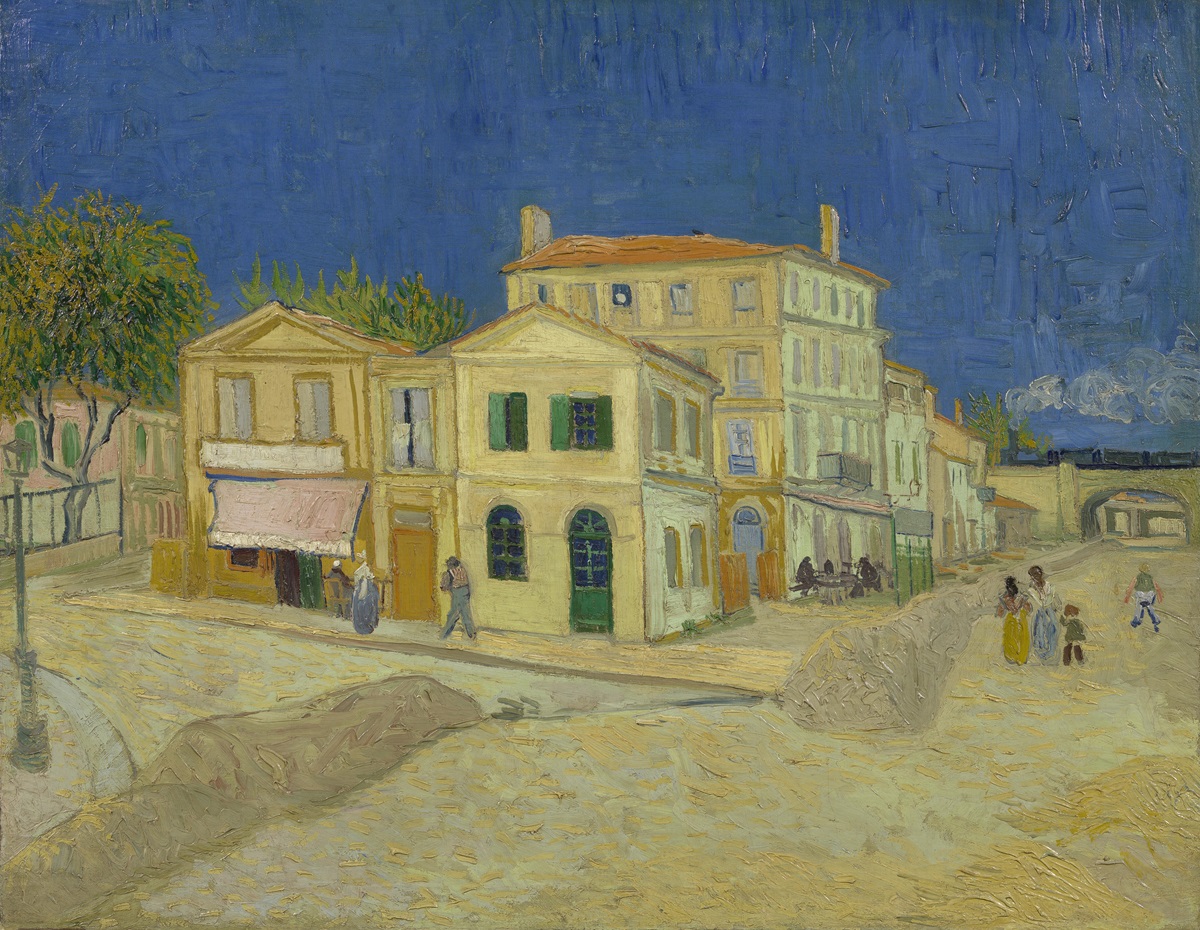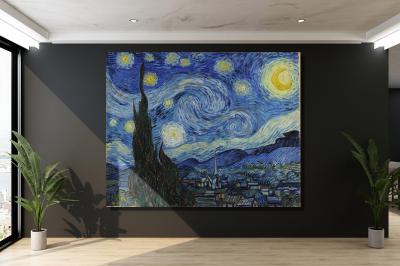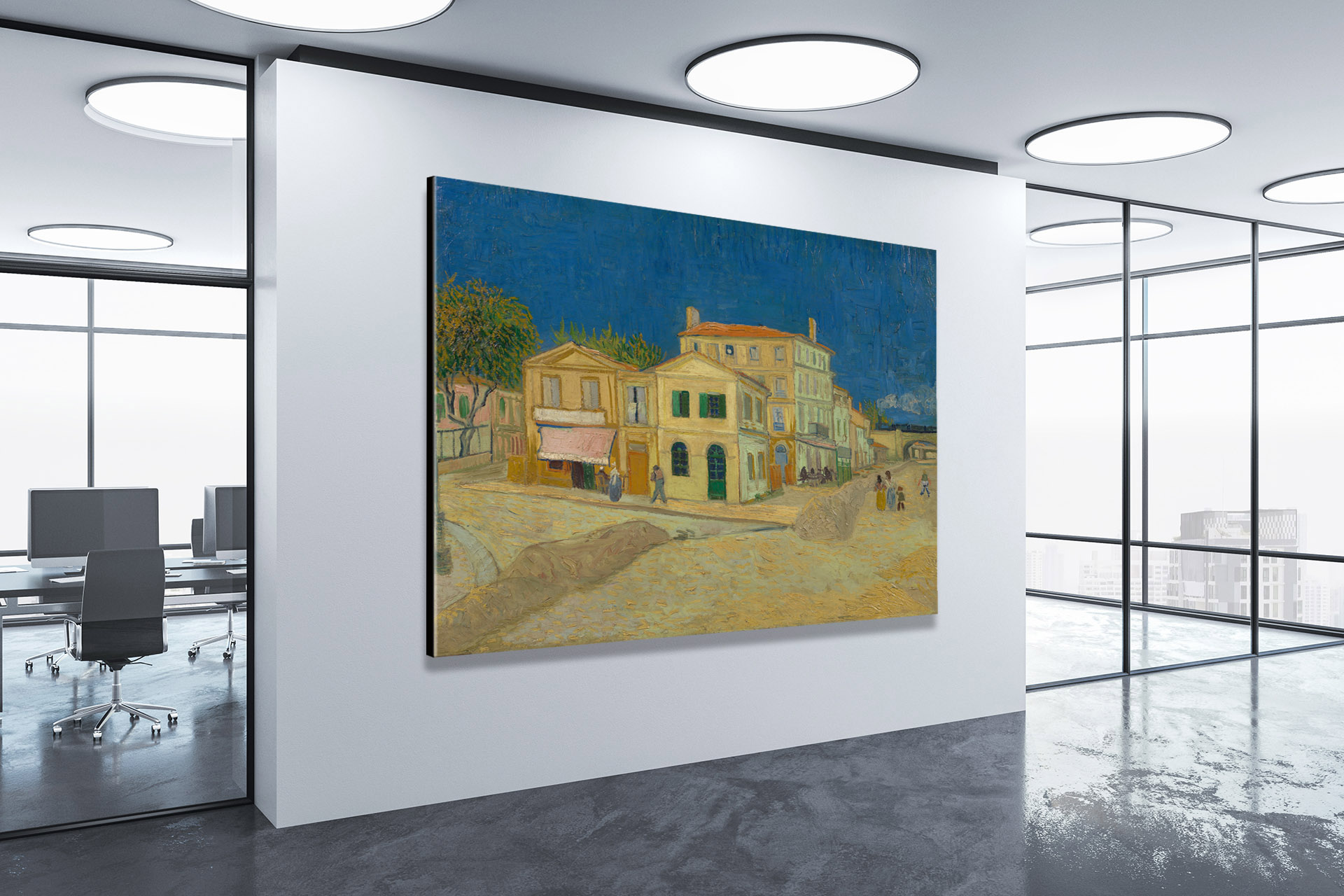The Yellow House
By Vincent van Gogh, 1888
Illuminating Life’s Vibrancy: Vincent van Gogh’s “The Yellow House”
Within the realm of art, Vincent van Gogh’s oeuvre is a testament to the profound connection between an artist’s life and their work. Among the gems of his creations, “The Yellow House” holds a unique place. This painting, resplendent with vibrant colors and laden with symbolism, offers a glimpse into van Gogh’s turbulent existence and extraordinary artistic brilliance. In this article, we will embark on an exhilarating exploration of “The Yellow House,” unraveling its historical context, the intricacies of its composition, the captivating narrative that envelops its creation, the technical challenges van Gogh encountered, the significance of its location, and an in-depth look at the painter himself.
The Context
“The Yellow House” came to life in 1888 during Vincent van Gogh’s stay in Arles, a picturesque town nestled in the sun-soaked landscapes of southern France. This particular period marked a transformative phase in the artist’s life, a time when he sought refuge from the bustling urban life of Paris in pursuit of artistic inspiration and personal tranquility. Van Gogh’s desire for a sense of home and belonging led him to rent a modest dwelling at 2 Place Lamartine, which would become famously known as “The Yellow House.”
“The Yellow House” Large Canvas Prints from WhiteClouds
Composition and Aesthetic Choices
At first glance, “The Yellow House” radiates with a pulsating warmth, dominated by the bold and brilliant hues of yellow and orange. Van Gogh’s daring choice of such vibrant colors serves as an emblem of his desire to infuse life with vitality and emotion. The composition is an exterior view of the house, characterized by its iconic sunflower yellow walls, standing in stark contrast against the serene blue sky. A picturesque façade adorned with vivid green shutters harmoniously complements the yellow, while a charming garden, complete with lush greenery and bursts of red plants, adds a touch of nature to the scene.
Van Gogh’s inimitable impasto technique comes to the forefront in “The Yellow House,” with thick, textured brushstrokes that seem to breathe with life. These swirling patterns of color and texture imbue the painting with a sense of movement and energy, as if the very essence of the house itself were alive and pulsating with creative fervor.
Emotion and Symbolism
Beneath the radiant surface of “The Yellow House” lies a profound reservoir of emotion and symbolism. For van Gogh, this house represented not merely a physical dwelling but a symbol of his quest for a stable and nurturing home and a sanctuary where he could immerse himself in his artistry.
The vibrant yellow façade of the house embodies hope, happiness, and the promise of new beginnings. For an artist who often grappled with mental health issues, the house stood as a refuge where he sought solace, meaning, and creative inspiration.
The presence of green shutters and the garden within the composition symbolize the harmonious coexistence of nature and human creation. Sunflowers, a recurring motif in van Gogh’s work, represent admiration and devotion. These sun-kissed blooms epitomize the artist’s fervent belief in the transformative power of art, signifying his aspiration to create a space of both physical and emotional beauty and inspiration.
Technical Challenges
While van Gogh’s use of vibrant colors and bold brushwork is celebrated, it also presented technical challenges. The impasto technique, characterized by thick layers of paint, required meticulous handling to achieve the desired texture and depth. Additionally, the use of such bold, contrasting colors demanded precise execution to maintain the overall harmony of the composition.
The Stormy Reality
Behind the luminous façade of “The Yellow House” lies a narrative of tumultuous relationships and profound inner turmoil. Van Gogh’s dream of establishing an artists’ collective within its walls was short-lived, marred by a series of conflicts with his fellow artist and housemate, Paul Gauguin. These tensions reached their peak in a notorious incident where van Gogh famously severed a portion of his own ear, a dramatic testament to the intensity of his emotions.
The house itself bore the scars of the storm, both metaphorical and literal, that raged within van Gogh’s life. It was physically damaged during a heavy storm, mirroring the tempestuousness of the artist’s existence. Intriguingly, van Gogh continued to paint “The Yellow House” even after the storm damage, suggesting that he was determined to immortalize his vision of a place brimming with hope and creative vitality, regardless of the challenges he faced.
The Significance of Location
The choice of Arles as the location for “The Yellow House” is significant. The town’s idyllic landscapes and radiant sunlight provided van Gogh with the inspiration he craved. Arles, with its charming streets and picturesque surroundings, served as both muse and sanctuary, a place where van Gogh’s artistic vision could flourish.
An In-Depth Look at the Painter
Vincent van Gogh, born in 1853, was a Dutch Post-Impressionist painter whose life was as tumultuous as his art was brilliant. He produced an astonishing body of work in a relatively short span, often wrestling with mental health issues and enduring personal struggles. Van Gogh’s unique style, characterized by bold brushwork, vivid colors, and a deep emotional intensity, defied traditional artistic conventions and left an indelible mark on the art world.
Van Gogh’s life was marked by a relentless pursuit of his artistic vision, driven by a profound desire to capture the essence of the human experience. He grappled with inner demons and moments of despair, yet his art remained a beacon of hope and beauty. His enduring legacy continues to inspire artists and art enthusiasts alike, a testament to the power of creativity in the face of adversity.
 The Yellow House by Vincent van Gogh
The Yellow House by Vincent van Gogh
Conclusion
Vincent van Gogh’s “The Yellow House” transcends being a mere painting; it is a profound manifestation of his unbridled passion for life and art. This iconic work encapsulates his yearning for a sense of belonging, a sanctuary of creativity, and a haven from the tempests that buffeted his existence. Through its vibrant colors, bold brushwork, layered symbolism, and the technical challenges van Gogh faced, “The Yellow House” invites us to peer into the artist’s inner world, offering a glimpse of his relentless pursuit of beauty amidst adversity. It stands as a vivid reminder that even in the face of life’s storms, the human spirit can radiate with the warmth of hope, creativity, and enduring artistic brilliance, reflecting the complex, extraordinary life of Vincent van Gogh himself.
Frequently Asked Questions About “The Yellow House”
What is the significance of “The Yellow House” in Vincent van Gogh’s career? “The Yellow House” is significant as it reflects a pivotal period in van Gogh’s artistic journey. It represents his time in Arles, where he aimed to create an artists’ collective and experimented with vibrant colors.
Where is the actual “Yellow House” located, and does it still exist today? The actual “Yellow House” was located in Arles, France, but it was destroyed during World War II. Today, a plaque marks its historical location.
What was the inspiration behind the choice of the vibrant yellow color for the house? Van Gogh chose the color yellow to evoke feelings of warmth, happiness, and hope. It symbolized his desire for a brighter, more vibrant life.
Can you explain the symbolism of the sunflowers in “The Yellow House”? Sunflowers were a symbol of admiration and devotion for van Gogh. In “The Yellow House,” they represent his admiration for the simple beauty of nature and his aspirations for his art.
What was the relationship between Vincent van Gogh and Paul Gauguin, and how did it influence “The Yellow House”? Vincent van Gogh and Paul Gauguin were fellow artists and housemates in Arles. Their relationship was complex and marked by creative collaboration and conflict. Gauguin’s presence influenced van Gogh’s work during this time.
Did the technical challenges in creating “The Yellow House” contribute to its significance? Yes, the technical challenges, including van Gogh’s use of impasto and bold colors, contributed to the painting’s significance. They added depth and intensity to the work, reflecting his emotional state.
How did the actual location of Arles influence van Gogh’s artistic vision for “The Yellow House”? Arles, with its vibrant colors, bright sunlight, and picturesque landscapes, deeply influenced van Gogh’s art. It provided the backdrop for his exploration of color and light in “The Yellow House.”
What happened to “The Yellow House” after van Gogh’s time in Arles? After van Gogh’s departure from Arles, the house changed ownership and faced various renovations. It was ultimately destroyed during World War II, making the painting a lasting testament to its existence.
Are there any known sketches or preparatory works related to “The Yellow House”? While there are sketches related to van Gogh’s other works, there are no known preparatory works specifically tied to “The Yellow House,” which adds to its mystique.
How does “The Yellow House” compare to van Gogh’s other famous works, such as “Starry Night” or “Sunflowers”? “The Yellow House” stands out as a representation of van Gogh’s time in Arles, characterized by vibrant colors and a unique vision of rural life. While different from “Starry Night” or “Sunflowers,” it showcases his diverse artistic range and emotional depth.
Other Articles on Vincent van Gogh Paintings
At Eternities Gate by Vincent Van Gogh, 1890
Blossoming Almond Tree by Vincent Van Gogh, 1890
Cafe Terrace at Night by Vincent Van Gogh, 1888
Daubigneys Garden by Vincent Van Gogh, 1890
Green Wheat Field with Cypress by Vincent Van Gogh, 1889
Houses at Auvers by Vincent Van Gogh, 1890
Irises by Vincent Van Gogh, 1889
Night Café by Vincent Van Gogh, 1888
Portrait of Dr. Gachet by Vincent Van Gogh, 1890
Red Vineyards by Vincent Van Gogh, 1888
Road with Cypress and Star by Vincent Van Gogh, 1890
Starry Night by Vincent Van Gogh, 1889
Starry Night over the Rhone by Vincent Van Gogh, 1888
Sunflowers by Vincent Van Gogh, 1887
The Bedroom by Vincent Van Gogh, 1888
The Church at Aurers by Vincent Van Gogh, 1890
The Garden of the Asylum by Vincent Van Gogh, 1889
The Mulberry Tree by Vincent Van Gogh, 1889
The Potato Eaters by Vincent Van Gogh, 1885
The Yellow House by Vincent Van Gogh, 1888
Tree Roots by Vincent Van Gogh, 1890
Van Gogh Self Portrait by Vincent Van Gogh, 1887
Vase with Red Poppies by Vincent Van Gogh, 1886
View of Arles by Vincent Van Gogh, 1889
Wheat Field with Crows by Vincent Van Gogh, 1890
Wheat Field with Cypresses by Vincent Van Gogh, 1889
More WhiteClouds Videos
Contact us today to learn more about our 3D services and how we can help you achieve your goals.

